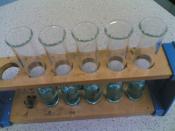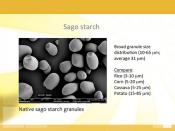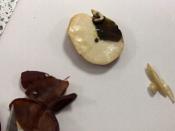very extensive lab... the results should be obtained by the reader who should have the info. good style and observations.
DETECTION OF BIOLOGICAL MOLECULES
Introduction: Without carbon, nitrogen, hydrogen, sulfur, oxygen and phosphorus, life
wouldn't exist. These are the most abundant elements in living organisms. These elements
are held together by covalent bonds, ionic bonds, hydrogen bonds, and disulfide bonds.
Covalent bonds are especially strong, thus, are present in monomers, the building blocks
of life. These monomers combine to make polymers, which is a long chain of monomers
strung together. Biological molecules can be distinguished by their functional groups. For
example, an amino group is present in amino acids, and a carboxyl group can always be
found in fatty acids. The groups can be separated into two more categories, the polar,
hydrophilic, and the nonpolar, hydrophobic. A fatty acid is nonpolar, hence it doesn't mix
with water. Molecules of a certain class have similar chemical properties because they
have the same functional groups.
A chemical test that is sensitive to these groups can be
used to identify molecules that are in that class. This lab is broken down into four
different sections, the Benedict's test for reducing sugars, the iodine test for the presence
of starch, the Sudan III test for fatty acids, and the Biuret test for amino groups present in
proteins. The last part of this lab takes an unknown substance and by the four tests,
determine what the substance is.
BENEDICT'S TEST
Introduction: Monosaccharides and disaccharides can be detected because of their free
aldehyde groups, thus, testing positive for the Benedict's test. Such sugars act as a
reducing agent, and is called a reducing sugar. By mixing the sugar solution with the
Benedict's solution and adding heat, an oxidation-reduction reaction will occur. The sugar
will oxidize,


